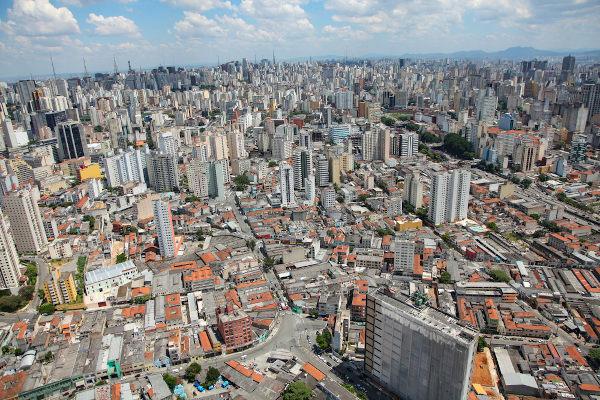The formation of the Brazilian territory began before the arrival of the Portuguese.
To avoid conflicts between Spain and Portugal, the two countries signed the Treaty of Tordesillas (1494). This established the limits of the lands to be occupied and exploited in America.
The first region to be populated by the Portuguese was the coast, especially the northeast. There, sugar cane plantations, sugar mills, and ports were established.
Parallel to this, the colonists organized expeditions in search of labor, metals and precious stones.
The Brazilian territory in the colonial period
The Treaty of Tordesillas forced the Portuguese to remain on the coast. As a result, the first economic activity was the exploration of pau-brasil and then the planting of sugar cane.
Note the appearance of the Brazilian map with the limits of the Treaty of Tordesillas and the hereditary captaincies:

With the Iberian Union (1580-1640), the Treaty of Tordesillas is no longer valid. In this way, Portuguese settlers can go inland. With this, they find gold and precious stones in the regions known today as Mato Grosso, Goiás and Minas Gerais.
With the end of the Iberian Union and the reestablishment of the monarchy in Portugal, the Portuguese expanded to the south and founded the Colonia do Sacramento in 1680. In order to protect those lands, the Spaniards respond by creating The Seven Peoples of the Missions where Jesuits and Guaraní Indians would live.
Subsequently, the War of Succession (1700-1713) begins in Europe, a dispute between the European powers to choose the next Spanish sovereign. This fight would also be reflected in the American colonies and would change the limits of Brazil.
With the end of the conflict, the Treaty of Utretch was signed, which established:
- the borders between Brazil and French Guiana
- Amapá, disputed between France and Portugal, was recognized as Portuguese
- the Colony of Sacramento was handed over to Spain
- the area occupied by the Sete Povos das Missões was ceded to Portugal.
See more: Treaty of Utretch (1713)
Territorial formation of Brazil in the 19th century
With the arrival of the Portuguese court to Rio de Janeiro, the territory of Brazil underwent new changes.
The mining activity lost strength and coffee became Brazil's main export product. With that, states like Minas Gerais, Rio de Janeiro and São Paulo gained importance.
The Banda Oriental del Uruguay was incorporated into Brazil as the Cisplatin Province and French Guiana was militarily occupied. In 1817, Brazil leaves French Guiana, but obtains recognition of possession of the mouth of the Amazon.
After independence, however, the United Provinces of Rio de la Plata claimed that the area of Cisplatine belonged to them and began to Cisplatin War (1825-1828). The solution is the creation of an independent State, the Oriental Republic of Uruguay.
At this time, the creation of the provinces of Alagoas (1817), Sergipe (1820), Amazonas (1850) and Paraná (1853) is registered.
Organization of Brazilian territory in the 20th century
With the proclamation of the Republic in 1889, the provinces are called "states".
Brazil increased in size during the 20th century. France claimed that part of Amapá belonged to it, as it did not recognize the Oiapoque River as a border.
In May 1900, after diplomatic disputes led by the Baron of Rio Branco, the issue was resolved in favor of Brazil and a strip of land of 250,000 km² was incorporated into the state of Pará.
However, the main territorial conflict was registered with Bolivia.
Both countries faced each other over the region that is currently the state of Acre. The confrontation gave rise to Acrean Revolution and ended with the incorporation of these lands by Brazil. Through the Treaty of Petrópolis, Bolivia was compensated and the Madeira-Mamoré railway was built.
Observe the appearance of the Brazilian territory in 1922 on the map below.

In the 20th century, we observed the territorial reorganization of Brazil with the creation of new states such as the Federal Territory of Guaporé (1943), Mato Grosso do Sul (1977) and Tocantins (1988). This responded to population growth and was also aimed at improving local administration.
The Federal Territory of Guaporé became the state of Rondônia in 1982. In turn, Amapá and Roraima were elevated to the status of states in 1988.
There are more texts on this subject for you:
- borders of Brazil
- Brazilian territory
- Treaty of Tordesillas
- Iberian Union
- Petropolis Treaty
- Baron of Rio Branco
- Brazil's map

